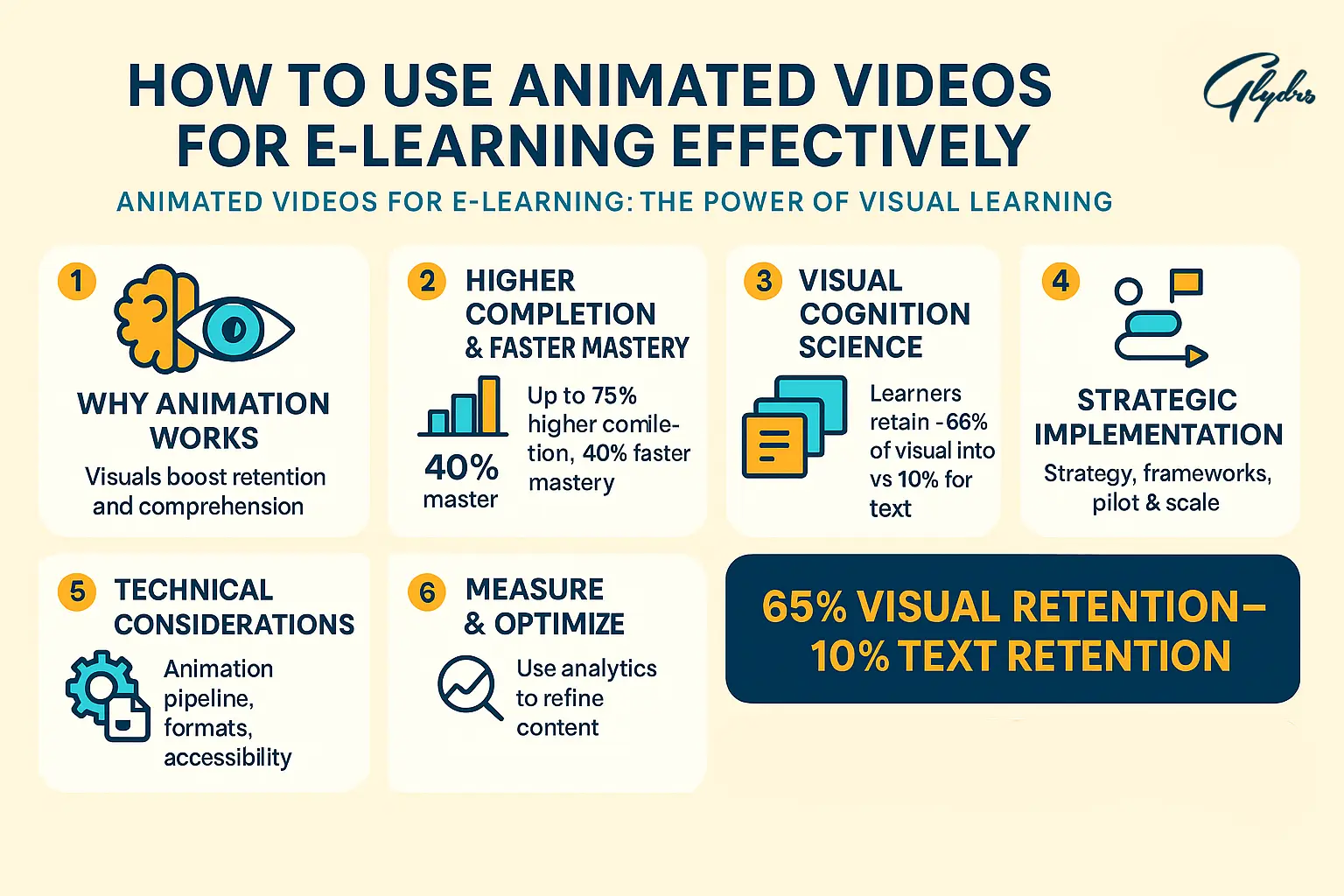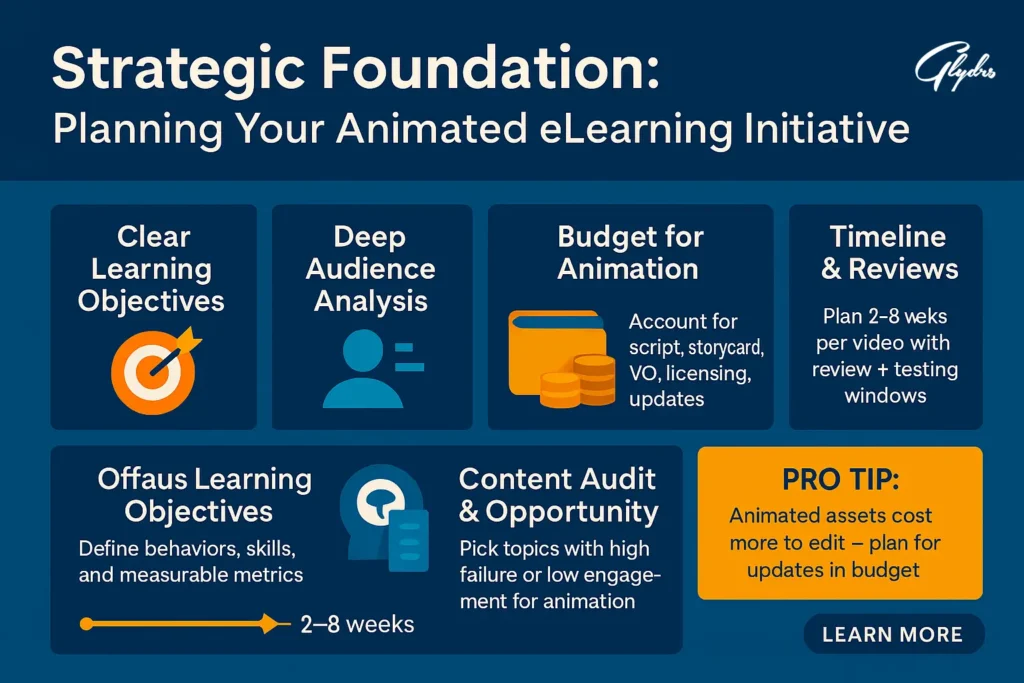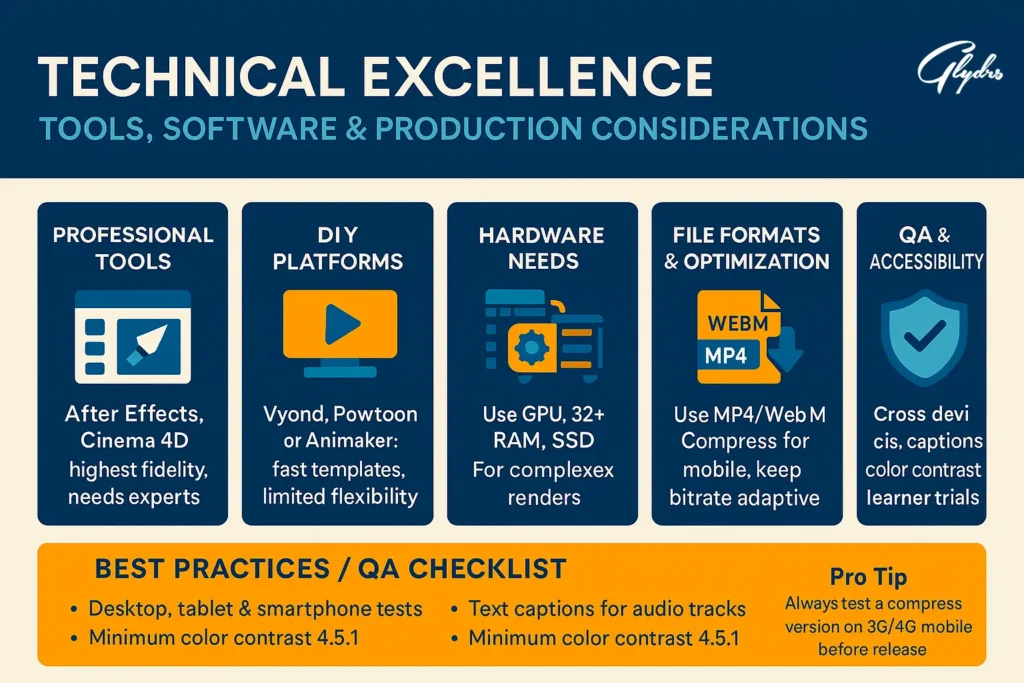
26 Aug How to Use Animated Videos for E-Learning Effectively
Animated Videos for E-Learning: The Power of Visual Learning
You’re living through a remarkable transformation in corporate training. Traditional PowerPoint presentations and lengthy manuals are giving way to dynamic, engaging animated videos for e-learning that capture attention and drive real learning outcomes. This shift isn’t just about keeping up with trends—it’s about recognizing that your learners’ brains are wired to process visual information more effectively than text alone.
Studies consistently show that learners retain 65% of visual information three days later, compared to only 10% of text-based content. When you incorporate animation into your eLearning strategy, you’re tapping into this fundamental aspect of human cognition. Your training programs can achieve completion rates up to 75% higher than traditional formats, while reducing the time needed to master complex concepts by as much as 40%.
As you embark on this comprehensive guide, you’ll discover not just the “what” and “why” of animated eLearning, but the critical “how”—the strategic approaches, technical considerations, and implementation frameworks that separate successful initiatives from costly experiments. You’re about to transform how your organization approaches learning and development.
Understanding the Animation Landscape: Types and Applications
Your first step toward effective implementation involves understanding the diverse world of animation styles available for educational content. Each type serves specific learning objectives and audience needs, much like choosing the right tool for a particular job.
Explainer videos serve as your content workhorses, perfect for breaking down complex concepts into digestible segments. When you need to introduce new software, explain company policies, or walk through multi-step processes, explainer videos combine clear narration with supportive visuals that guide learners through each point methodically.
Whiteboard animation offers you a uniquely engaging storytelling format that mimics the experience of watching an expert teacher work through problems in real-time. You’ll find this style particularly effective for step-by-step tutorials, historical timelines, or any content where the sequential revelation of information enhances understanding.
Motion graphics offer sophisticated visual communication tools that excel at presenting data, statistics, and abstract concepts. When you need to make quarterly results engaging or explain market trends, motion graphics can transform dry numbers into compelling visual narratives that stick with your audience.
Character animation empowers you to create emotional connections and memorable scenarios. You can develop relatable personas that guide learners through challenging situations, role-play difficult conversations, or demonstrate best practices in context. This approach proves especially valuable for soft skills training and compliance scenarios.
3D animation opens up possibilities for immersive technical training that would be impossible or dangerous in real life. You can take learners inside machinery, through molecular structures, or into architectural spaces, providing perspectives that enhance spatial understanding and technical comprehension.Modern animated videos for e-learning often combine multiple styles within a single piece, allowing you to match the animation approach to specific content segments for maximum impact and engagement.
The Science Behind Animated eLearning Success
Your investment in animated content is backed by solid cognitive science research that explains why visual learning creates such powerful results. Understanding these principles helps you make informed decisions about when and how to deploy animation most effectively.
The dual coding theory demonstrates that your learners’ brains process visual and auditory information through separate channels simultaneously. When you present information through both animated visuals and narration, you’re essentially doubling the cognitive pathways available for encoding and retrieval. This redundancy significantly improves both comprehension and long-term retention.
Cognitive load theory explains why animated videos work so well for complex subjects. You can use animation to reduce extraneous cognitive burden by eliminating unnecessary visual elements, highlighting key concepts through motion, and presenting information in logical sequences that align with natural mental processing patterns.
Your learners also benefit from the picture superiority effect, which shows that information presented as images is more likely to be remembered than equivalent text. When you animate these images, you add the dimension of time and sequence, creating even stronger memory traces that learners can access more easily during performance.
Animation triggers emotional engagement through character identification, humor, and narrative elements that text-based training simply cannot match. This emotional connection doesn’t just make learning more enjoyable—it strengthens memory formation by activating multiple regions of the brain simultaneously.For learners with different processing styles, animated videos for e-learning provide multiple access points to the same information. Visual learners can focus on the graphics and animations, auditory learners can concentrate on the narration, and kinesthetic learners can engage with interactive elements you embed within the content.

Strategic Foundation: Planning Your Animated eLearning Initiative
Your success with animated eLearning begins long before any creative work starts. Strategic planning establishes the framework that guides every subsequent decision and ensures your investment delivers measurable returns.
Start by defining crystal-clear learning objectives that go beyond simple knowledge transfer. You need to identify specific behavioral changes you want to see, skills learners must demonstrate, and performance metrics that will indicate success. These objectives become your north star throughout the entire production process.
Your audience analysis must dig deeper than basic demographics. You need to understand your learners’ current skill levels, preferred learning modalities, available time for training, and the devices they’ll use to access content. Consider their motivation levels, potential resistance to new training formats, and the workplace contexts where they’ll apply their learning.
Budget planning for animated content requires you to think beyond initial production costs. You’ll need to account for script development, storyboarding, voice-over talent, music licensing, platform integration, and ongoing maintenance. Factor in the cost of updates and revisions, as animated content typically requires more resources to modify than text-based materials.
Your content audit should identify which existing materials are prime candidates for animation treatment. Look for topics with high failure rates, low engagement scores, or complex concepts that learners consistently struggle to master. These represent your best opportunities for dramatic improvement through animation.
Timeline development must balance quality requirements with business needs. High-quality animation takes time, typically ranging from 2-8 weeks for a single video, depending on complexity and revision cycles. You’ll need to coordinate with multiple stakeholders, manage feedback loops, and allow adequate time for testing before deployment.
The Complete Creation Process: From Concept to Completion
Your animation journey follows a structured process that transforms educational objectives into engaging visual experiences. Each phase builds on the previous one, requiring careful attention to detail and stakeholder alignment.
The discovery phase involves deep collaboration with subject matter experts to understand not just what needs to be taught, but how learners currently struggle with the material. You’ll identify the specific moments where comprehension breaks down, the misconceptions that commonly arise, and the real-world contexts where knowledge must be applied.
Script development requires striking a balance between educational effectiveness and engaging storytelling. You need to write conversationally while maintaining technical accuracy, incorporate adult learning principles that keep the content engaging, and structure the information flow to support both linear viewing and random access patterns.
Your storyboarding process translates written concepts into visual sequences. This phase allows you to experiment with pacing, identify potential production challenges, and ensure visual elements support rather than compete with educational objectives. Detailed storyboards prevent costly revisions during animation production.
Art direction decisions establish the visual identity that will carry through your entire program. You’ll choose color palettes that align with your brand while supporting readability, select character designs that represent your diverse workforce, and establish animation styles that match the formality level appropriate for your content.
The production workflow involves careful coordination between animators, voice talent, sound designers, and quality reviewers. You’ll need systems for version control, feedback integration, and approval tracking that keep projects moving efficiently while maintaining quality standards.Testing and optimization occur throughout production rather than just at the end. You’ll conduct regular reviews with target learners, test content across different devices and platforms, and refine elements based on real user feedback before final delivery.
Implementation Best Practices for Maximum Impact
The success of your animated content depends heavily on how thoughtfully you implement it within your broader learning ecosystem. Smart implementation strategies can amplify the effectiveness of your content, while poor execution can undermine even the highest-quality animations.
Optimal video length depends on content complexity and learner context, but research consistently shows that engagement drops significantly after the 6-minute mark for most topics. You’ll achieve better results by breaking complex subjects into 3-5 minute segments that learners can consume individually or in sequence based on their needs and available time.
Your pacing strategy must account for the increased cognitive processing required by animated content. Build in deliberate pauses after key concepts, use visual transitions to signal topic changes, and provide clear progress indicators so learners can manage their cognitive resources effectively.
Platform integration requires technical testing across all delivery methods your learners will use. Ensure videos play smoothly on mobile devices, load quickly over limited bandwidth connections, and integrate seamlessly with your existing LMS tracking and reporting systems.
Interactive elements transform passive viewing into active learning experiences. You can embed knowledge checks at strategic points, provide clickable hotspots that reveal additional information, and create branching scenarios where learner choices influence the content path.
Microlearning approaches leverage animation’s strength in explaining discrete concepts quickly and memorably. Design your animated videos for e-learning as standalone modules that can be combined flexibly, rather than linear sequences that must be consumed in order.Assessment integration should feel natural rather than interrupting the learning flow. Use animation to present realistic scenarios for evaluation, incorporate self-reflection prompts that appear seamlessly within the content, and provide immediate feedback that reinforces correct understanding.

Technical Excellence: Tools, Software, and Production Considerations
Your technology choices significantly impact both the quality of your final product and the efficiency of your production process. Understanding the capabilities and limitations of different approaches helps you make informed decisions that align with your resources and objectives.
Professional animation software like Adobe After Effects, Cinema 4D, and Toon Boom offer unlimited creative possibilities but require specialized expertise and significant time investment. These tools produce the highest quality results but may not be practical for organizations without dedicated animation teams.
DIY animation platforms such as Vyond, Powtoon, and Animaker provide templates and simplified workflows that allow non-experts to create animated content. While these tools limit creative flexibility, they can produce effective results for straightforward educational content with much faster turnaround times.
Your hardware requirements depend on the complexity of the animations you plan to create. Professional animation requires powerful graphics processors, substantial RAM, and fast storage systems. Even DIY platforms benefit from modern computers with good graphics capabilities for smooth preview and rendering.
File format optimization ensures your content performs well across different devices and network conditions. You’ll need to balance visual quality with file size, choosing appropriate compression settings that maintain clarity while enabling smooth playback on mobile devices over cellular connections.
Scalability considerations become critical as your program grows. Establish template systems and style guides that enable consistent production across multiple creators, implement asset libraries that can be reused across projects, and create workflow documentation that supports team expansion.Quality assurance protocols should include technical testing across target devices, accessibility compliance verification, and educational effectiveness validation with representative learners before content deployment.
Measuring Success: Analytics, Assessment, and Continuous Improvement
Your animated eLearning investment deserves rigorous measurement to ensure it’s delivering the promised returns. Effective measurement goes beyond simple completion rates to examine actual learning outcomes and behavioral changes.
Engagement metrics provide immediate feedback about content effectiveness. Track completion rates, replay frequency, pause patterns, and drop-off points to identify content segments that may need refinement. High replay rates often indicate particularly valuable or challenging content sections.
Learning analytics help you understand how animated content fits into broader learning journeys. Examine the relationship between animation viewing and assessment performance, time-to-competency improvements, and retention rates compared to traditional training methods.
Performance correlation analysis connects training metrics to workplace outcomes. Look for relationships between animation engagement and job performance indicators, safety incident reductions, or customer satisfaction improvements that demonstrate real business impact.
A/B testing strategies allow you to optimize content systematically. Test different animation styles, pacing approaches, or interactive element placements to identify what works best for your specific audience and content types.
Cost-effectiveness measurement should include both direct production costs and indirect benefits like reduced training time, improved knowledge retention, and decreased need for remedial training. Calculate the total cost per learning outcome achieved rather than just cost per video produced.Feedback collection systems provide qualitative insights that quantitative metrics cannot capture. Implement structured feedback processes that gather learner reactions immediately after viewing and again after workplace application to understand both immediate impact and long-term value.
Avoiding Common Pitfalls and Implementation Challenges
Your animation initiative faces predictable challenges that you can anticipate and mitigate with proper planning. Learning from others’ mistakes helps you avoid costly errors and accelerate your path to success.
Over-animation syndrome occurs when creators become so enamored with animation capabilities that they lose sight of educational objectives. Every animated element should serve a specific learning purpose. Gratuitous motion, excessive visual effects, and complex transitions can impair comprehension by overwhelming learners’ cognitive processing capacity.
Script and pacing problems often emerge when creators underestimate the time needed to process animated information. Your narration pace must accommodate visual processing time, key concepts need adequate emphasis. And transitions between topics require sufficient spacing to prevent cognitive overload.
Technical compatibility issues can undermine even excellent content. Test your animated videos for e-learning across all target devices, browsers, and network conditions before full deployment. Pay particular attention to mobile performance, as many learners will access content on smartphones or tablets.
Budget overruns frequently occur when the scope creeps beyond the initial parameters. Establish clear change management processes, document all requirements upfront. And build contingency buffers into your budget for inevitable adjustments and refinements.
Adoption resistance may emerge from learners accustomed to traditional training methods or concerned about technology complexity. Address this through change management communication that emphasizes benefits, provides technical support. And recognizes early adopters who can serve as peer advocates. Maintenance planning often gets overlooked during initial enthusiasm, but becomes critical as content ages. Plan for regular updates, establish processes for incorporating feedback, and budget for periodic refreshes to keep content current and engaging.
Future-Proofing Your Strategy: Emerging Trends and Technologies
Your animation strategy must evolve with rapidly advancing technology while maintaining focus on fundamental learning principles. Understanding emerging trends helps you make informed investment decisions and prepare for future opportunities.
Artificial intelligence is beginning to automate aspects of animation production. From auto-generating storyboards based on scripts to creating basic character animations from text descriptions. While these tools won’t replace human creativity, they can significantly reduce production time and costs for routine content.
Personalization capabilities are advancing beyond simple branching scenarios to create truly adaptive learning experiences. Future systems will adjust animation pacing, complexity, and examples based on individual learner performance and preferences in real-time.
Virtual and augmented reality integration. Offers possibilities for immersive animated experiences that place learners inside scenarios rather than watching them unfold. While still emerging, these technologies show particular promise for technical training and safety scenarios.
Voice AI and natural language processing. Will enable more sophisticated interactive animated characters that can respond to learner questions. And provide personalized guidance throughout the learning experience.
Mobile-first design principles continue evolving as smartphone capabilities expand. Future animated videos for e-learning will be designed primarily for mobile consumption. With desktop versions as secondary considerations rather than the reverse. Sustainability considerations are becoming increasingly important as organizations focus on environmental impact. Cloud-based animation tools, efficient compression algorithms. And streamlined production workflows can significantly reduce the carbon footprint of content creation and delivery.
Transforming Learning Experiences Through Strategic Animation
You now possess the comprehensive knowledge needed to implement animated eLearning successfully within your organization. The journey from traditional training methods to engaging animated experiences requires careful planning, strategic thinking. And commitment to continuous improvement, but the potential returns justify the investment.
Your success will depend on maintaining focus on learning outcomes while embracing the creative possibilities that animation offers. Remember that technology serves education, not the reverse. The most sophisticated animations will fail if they don’t address real learning needs and support measurable performance improvements.
Building internal capabilities versus outsourcing represents a strategic decision that depends on your organization’s size. Resources, and long-term commitment to animated content. Many successful programs combine internal strategic oversight with external creative expertise to achieve optimal results.
Creating a culture of continuous learning and innovation requires leadership support, adequate resources. And a willingness to experiment with new approaches. Your animated eLearning initiative can catalyze broader transformation in how your organization approaches employee development.
The organizations that will thrive in the coming decade are those that recognize learning and development as competitive advantages rather than necessary expenses. Animated videos for e-learning represent one of the most powerful tools available for creating these advantages. Combining engagement, effectiveness, and efficiency in ways that traditional methods cannot match.
Your next steps involve conducting a thorough assessment of your current training challenges. Identifying high-impact opportunities for animation implementation. And developing a phased rollout plan that allows for learning and refinement along the way. Start small, measure rigorously, and scale based on demonstrated success.
The future of corporate learning is visual, interactive, and engaging. You have the knowledge and tools needed to lead your organization toward that future. The question isn’t whether animated eLearning will transform your training programs. It’s how quickly and effectively you’ll make that transformation happen.


No Comments